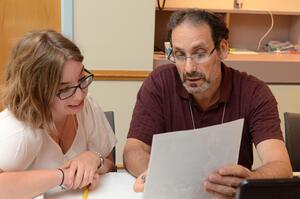Understanding Primary Sources
Claire Solomon and Rabbi Reuven Travis learn together at the 2012 Institute for Educators.
Photo by Gus Freedman.
Copyright 2012 Jewish Women's Archive.
In the first issue of The American Jewess, its editor, Rosa Sonneschein, observed that it is "Not what has happened, but what is recorded makes history." As educators, it is extremely important for us to consider not only what history we teach, but also how we are providing entry points for students into the experiences of their predecessors.
At JWA we believe that stories bring history alive for students. Captured in letters, interviews, and photographs, the real-life experiences of American Jews allows our students to make explicit connections between their own lives, their passions and concerns, and the experiences of those who came before.
Teaching with primary sources isn’t always easy, but here you will find many resources, websites, tools, and ideas that will help you lift history off the pages of books and put it into the context of life—which is exciting, complicated, challenging, and satisfying.
What are primary sources?
Primary sources are the creations of people who witnessed or took part in historical events. When we take a photograph of a birthday party, write a diary entry, or send a Tweet, we are creating primary sources. Primary sources are completely subjective as they are created from the point of view of one specific person. By studying primary sources historians, (and students) can uncover many sides of a story and shed light on the personal experiences of people who were present at a particular time and place.
For more about primary sources, and to see a list of different kinds of primary sources, visit primarysource.org.
Graphic Organizers
We have created a few graphic organizers that students and teachers can use to help explore and investigate primary sources. We have also included some others that are free and available online.
- Fact, Feeling, Idea, Question—this chart, created for the Living the Legacy project, gives students an opportunity to observe and ask questions about a primary source document, be it a photo or a piece of text.
- Primary Source Analysis Tool—use this graphic organizer from the Library of Congress to respond to what they see or read in primary source documents. Includes ideas for follow-up activities and directions for use.
Resources from JWA
- Tackling Text: Ideas for adapting text-based primary sources for learners of all ages and abilities.
- Teaching With Primary Sources: an exercise for teachers working alone or in groups to explore strategies for teaching primary sources, find curricular connections that lend themselves to primary source study, and consider strategies that support student comprehension and engagement.
- In Our Own Voices Oral History Guide: a step-by-step guide for collecting oral histories in your family or community. The Family History Tool Kit (from JWA's MyBatMitzvahStory.org) is a kid-friendly version of this guide.
Other free, online resources
- Primary Source offers online materials, training programs, and information about using primary sources as well as resources for use in classrooms and educational settings.
- Visual Thinking Strategies is a teaching method that centers on open-ended yet highly-structured discussions of visual art. It can be used with learners of all ages, and is very effective when applied to the study of photographs, political cartoons, propaganda posters, and other visual primary sources.
- The Library of Congress has many different resources for teachers who want to use primary sources as well as opportunities for training and professional development.
- Facing History and Ourselves has many resources for educators in different settings. This extensive list of teaching strategies has activities that can be adapted for different age groups, settings and purposes. The 3-2-1 activity and this exercise on analyzing visual images are great tools for working with primary sources.



